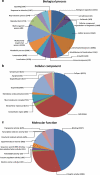Transcriptome profiling of the fifth-stage larvae of Angiostrongylus cantonensis by next-generation sequencing
- PMID: 23828188
- PMCID: PMC3742962
- DOI: 10.1007/s00436-013-3495-z
Transcriptome profiling of the fifth-stage larvae of Angiostrongylus cantonensis by next-generation sequencing
Abstract
Angiostrongylus cantonensis is an important zoonotic nematode. It is the causative agent of eosinophilic meningitis and eosinophilic meningoencephalitis in humans. However, information of this parasite at the genomic level is very limited. In the present study, the transcriptomic profiles of the fifth-stage larvae (L5) of A. cantonensis were investigated by next-generation sequencing (NGS). In the NGS database established from the larvae isolated from the brain of Sprague-Dawley rats, 31,487 unique genes with a mean length of 617 nucleotides were assembled. These genes were found to have a 46.08% significant similarity to Caenorhabditis elegans by BLASTx. They were then compared with the expressed sequence tags of 18 other nematodes, and significant matches of 36.09-59.12% were found. Among these genes, 3,338 were found to participate in 124 Kyoto Encyclopedia of Genes and Genomes pathways. These pathways included 1,514 metabolisms, 846 genetic information processing, 358 environmental information processing, 264 cellular processes, and 91 organismal systems. Analysis of 30,816 sequences with the gene ontology database indicated that their annotations included 5,656 biological processes (3,364 cellular processes, 3,061 developmental processes, and 3,191 multicellular organismal processes), 7,218 molecular functions (4,597 binding and 3,084 catalytic activities), and 4,719 cellular components (4,459 cell parts and 4,466 cells). Moreover, stress-related genes (112 heat stress and 33 oxidation stress) and genes for proteases (159) were not uncommon. This study is the first NGS-based study to set up a transcriptomic database of A. cantonensis L5. The results provide new insights into the survival, development, and host-parasite interactions of this blood-feeding nematode.
Figures



Similar articles
-
Excretory/secretory products of Angiostrongylus cantonensis fifth-stage larvae induce endoplasmic reticulum stress via the Sonic hedgehog pathway in mouse astrocytes.Parasit Vectors. 2020 Jun 18;13(1):317. doi: 10.1186/s13071-020-04189-w. Parasit Vectors. 2020. PMID: 32552877 Free PMC article.
-
Extracellular vesicles from fifth-stage larval Angiostrongylus cantonensis upregulate cholesterol biosynthesis and suppress NLRP2-associated inflammatory responses in mouse astrocytes.mSystems. 2025 Jan 21;10(1):e0101424. doi: 10.1128/msystems.01014-24. Epub 2024 Dec 5. mSystems. 2025. PMID: 39636121 Free PMC article.
-
Comparative studies on the proteomic expression patterns in the third- and fifth-stage larvae of Angiostrongylus cantonensis.Parasitol Res. 2014 Oct;113(10):3591-600. doi: 10.1007/s00436-014-4024-4. Epub 2014 Jul 16. Parasitol Res. 2014. PMID: 25028210
-
[Advances in pathogenic mechanisms of Angiostrongylus cantonensis infection].Zhongguo Xue Xi Chong Bing Fang Zhi Za Zhi. 2019 Mar 16;31(1):98-104. doi: 10.16250/j.32.1374.2018305. Zhongguo Xue Xi Chong Bing Fang Zhi Za Zhi. 2019. PMID: 31016931 Review. Chinese.
-
Angiostrongylus (Parastrongylus) cantonensis on intermediate and definitive hosts in Ecuador, 2014-2017.Biomedica. 2019 Jun 15;39(2):370-384. doi: 10.7705/biomedica.v39i3.4387. Biomedica. 2019. PMID: 31529823 Review. English, Spanish.
Cited by
-
Comparative transcriptomic analysis of two important life stages of Angiostrongylus cantonensis: fifth-stage larvae and female adults.Genet Mol Biol. 2017 Apr-Jun;40(2):540-549. doi: 10.1590/1678-4685-GMB-2016-0274. Genet Mol Biol. 2017. PMID: 28644509 Free PMC article.
-
Angiostrongylus cantonensis Meningo-Encephalitis in Children-Heightened Awareness Needed During Prolonged Wet Weather Conditions.J Paediatr Child Health. 2025 Mar;61(3):472-481. doi: 10.1111/jpc.16780. Epub 2025 Jan 17. J Paediatr Child Health. 2025. PMID: 39821425 Free PMC article.
-
The excretory/secretory products of fifth-stage larval Angiostrongylus cantonensis induces autophagy via the Sonic hedgehog pathway in mouse brain astrocytes.PLoS Negl Trop Dis. 2020 Jun 1;14(6):e0008290. doi: 10.1371/journal.pntd.0008290. eCollection 2020 Jun. PLoS Negl Trop Dis. 2020. PMID: 32479527 Free PMC article.
-
Perusal of parasitic nematode 'omics in the post-genomic era.Mol Biochem Parasitol. 2017 Jul;215:11-22. doi: 10.1016/j.molbiopara.2016.11.003. Epub 2016 Nov 22. Mol Biochem Parasitol. 2017. PMID: 27887974 Free PMC article. Review.
-
Identification and characterization of an asparaginyl endopeptidase from Angiostrongylus cantonensis.Parasitol Res. 2014 Jun;113(6):2143-52. doi: 10.1007/s00436-014-3866-0. Epub 2014 Apr 3. Parasitol Res. 2014. PMID: 24696276
References
-
- Alicata JE. Angiostrongyliasis cantonensis (eosinophilic meningitis): historical events in its recognition as a new parasitic disease of man. J Wash Acad Sci. 1988;78:38–46.
-
- Balasubramanian N, Toubarro D, Nascimento G, Ferreira R, Simões N. Purification, molecular characterization and gene expression analysis of an aspartic protease (Sc-ASP113) from the nematode Steinernema carpocapsae during the parasitic stage. Mol Biochem Parasitol. 2012;182:37–44. doi: 10.1016/j.molbiopara.2011.12.001. - DOI - PubMed
-
- Banora MY, Rodiuc N, Baldacci-Cresp F, Smertenko A, Bleve-Zacheo T, Mellilo MT, Karimi M, Hilson P, Evrard JL, Favery B, Engler G, Abad P, de Almeida Engler J. Feeding cells induced by phytoparasitic nematodes require γ-tubulin ring complex for microtubule reorganization. PLoS Pathog. 2011;7:e1002343. doi: 10.1371/journal.ppat.1002343. - DOI - PMC - PubMed
Publication types
MeSH terms
Substances
LinkOut - more resources
Full Text Sources
Other Literature Sources

